Saturday, September 11, 2004
Silvered Æ antoninianus, Salonina, Rome, Göbl 580aa
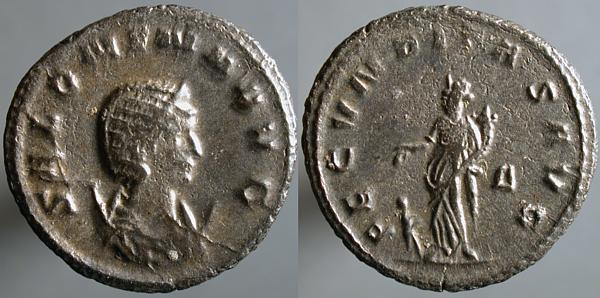
SALONINA AVG, Diademed draped bust right on crescent | FECVNDITAS AVG, Fecunditas standing facing, head left, holding cornucopia right, reaching down to child, left. Δ in right field.
I've said before: sometimes the Romans seem very like us, sometimes very unlike. Here's a common reverse theme for coins of empresses: fecundity, fertility. The Romans continued the convenient fiction of being a republic lead by a first among equals, but taking this much interest in the reproductive success of that first citizen is a pretty solid sign of a hereditary absolute monarchy.
Friday, September 10, 2004
Æ tetradrachm, Alexandria, Gallienus, Emmett 3803(8)
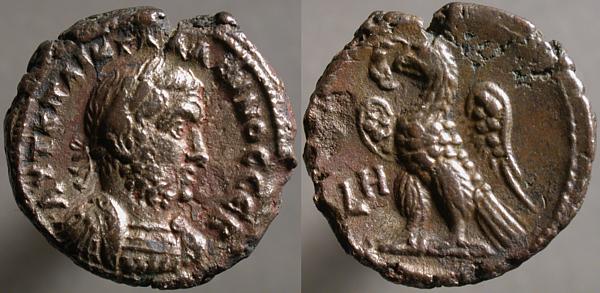
ΑVΤ Κ Π ΛΙΚ ΓΑΛΛΙΗΝΟC CΕΒ, Laureate cuirassed bust right | LΗ, Eagle standing left, holding wreath. Regnal year in left field.
Minted in 259-260, the last year of the joint reign of Valerian and Gallienus, during which Valerian would soon conduct his ill-advised adventure against Shapur, this coin features an eagle, not only the conventional symbol of Roman might while they dominated Egypt, but also a very common feature on the coins of the Ptolemaic kings, as this example, a 41mm, 51 gram coin of Ptolemy II Philadelphos, builder of the Pharos, shows.
Thursday, September 09, 2004
Silvered Æ antoninianus, Gallienus, Antioch, Göbl 1647a
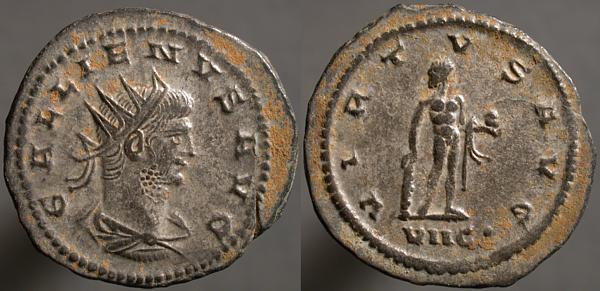
GALLIENVS AVG, Radiate draped bust right | VIRTVS AVG, Hercules standing facing, head left, holding club on ground left, holding apples of the Hesperides right, lion-skin draped over arm. VIIC· in exergue.
For those who're not interested in intensely collecting the coins of one emperor or imperial family, a thematic collection may appeal, and coins featuring the twelve labors of Hercules is an interesting and challenging area. Coins showing the first labor, slaying the Nemean lion are readily found, but some of the later labors are difficult.
Since Hercules sent Atlas to get the apples, scenes of the labor itself are not generally seen, but this seen showing Hercules holding the apples themselves ought to serve.
Wednesday, September 08, 2004
All better now
Yay, Blogger's able to publish again!
AR double victoriatus, Thessalian League, 196-146 BCE, Sear 2233
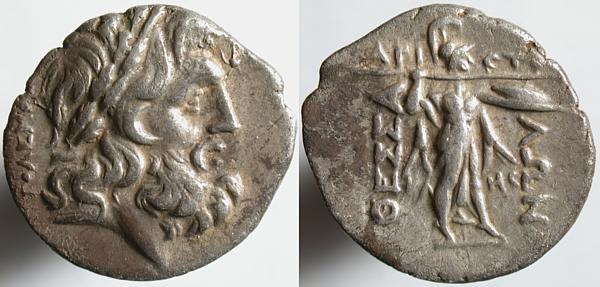
Head of Zeus wearing oak-leaf crown right, ΠΤΟΛΕΜΑ[ΙΟΥ] behind | Athena Itonia with helmet, spear, shield, and aegis, advancing right, ΘΕΣΣΑ_ΛΩΝ along sides, ΑΡΙ_CΤΟ across upper field, ΚΛ_ΗC across lower fields.
Probably struck at Larissa, after the Roman victory over the forces of Philip V, these aren't particularly rare. I think the obverse head of Zeus is quite beautiful, though. The reverse, with Athena's neck stretched so her head isn't obscured by the spear, is rather disappointing.
Still, it's not part of any series that I'm collecting, I bought it simply because I like it.
Tuesday, September 07, 2004
Æ27, Heliopolis in Coele-Syria, Gallienus, unknown
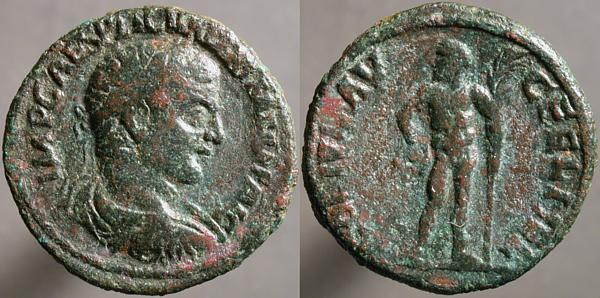
IMP CAES P LIC VALERIAN[VS P F ]AVG, Laureate draped bust right | COL IVL AV_G FEL HEL, Athlete (boxer) standing facing, head left, holding olive wreath left and palm right.
Books on ancient numismatics are expensive to produce, with extensive plates and heavy, glossy, paper. They sell in small numbers: no book can hope to cover the entire ancient world, or even the classical world, for 2,000 years. A book that comprehensively covers the coins of one city or region is of little interest to those who don't collect that part of the world.
While imperial coins are covered fairly comprehensively covered in the Roman Imperial Coins series (though some volumes badly need updated,) attempts to produce similarly comprehensive coverage of Greek coins, from the 5th century BCE through the end of provincial coinage under the Romans c. 296 CE, have never progressed beyond a volume or two of a province or two.
I can't find this listed in any catalog I own, and have ordered the catalog of the British Museum Collection for Galatia, Cappadocia and Syria, and SNG Poland, Volume 1, The Archeological and Ethnographical Museum in Lodz, Part 4. Perhaps I'll find it one of those two books, or perhaps I'll find an attribution for some other coin that I own, or will own.
Trivial update, October 4: Neither book lists this coin, my search continues.
Monday, September 06, 2004
Counterfeit Æ antoninianus, Gallienus, Rome, like Göbl 732b
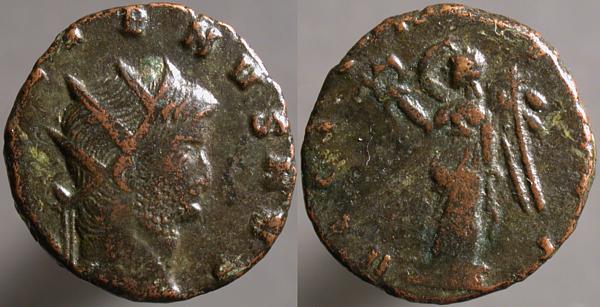
[GALL]IENVS AVG, Radiate head right | VICTOR[IA AVG III], Victory advancing left, raising wreath left, holding palm right.
From the deficient size and weight (15.7x16.6mm, 2.30g), as well as the flattened portrait, I'm convinced that this, while ancient, is not official mint product. The Romans took counterfeiting seriously and executed those caught at it. As the value of these coins was quite low it seems a small payoff for such a great risk, but that low value meant that most transactions took many coins, and a few counterfeits could be mixed with a larger number of legitimate items.
Sunday, September 05, 2004
Æ29, Ephesus in Ionia, Valerian, SNG Copenhagen 503
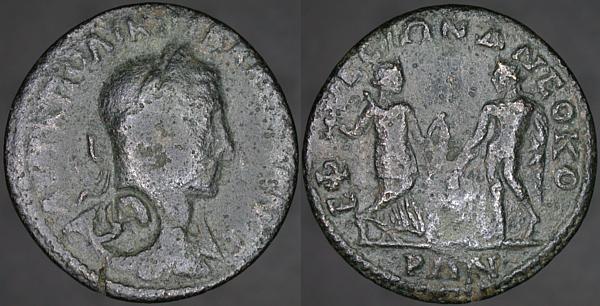
ΑVΤ Κ ΠΟ ΛΙΚΙΝ ΒΑΛΕΡΙΑΝΟC, Laureate draped cuirassed bust right, Stigma counterstamp. SNG Copenhagen does not show the counterstamp. | ΕΦ_ΕCΙΩΝ ΝΕΩΚΟ / ΡΩΝ, Artemis, to left, holding branch left and bow right, facing Apollo to right, holding branch right
The counterstamp here is a Greek numeral, applied sometime after the coin was minted, marking its value as six units.
Roman names sometimes didn't transliterate into Greek very well. While Volusian is probably the most egregious example, the initial V in Valerianus was a poor fit. Most coins seem to render it ΟVΑΛΕΡΙΑΝΟC, but this uses the less-frequently seen ΒΑΛΕΡΙΑΝΟC.
Other coins of this emperor, from this city use the more common spelling.

